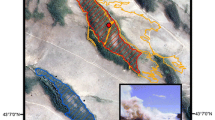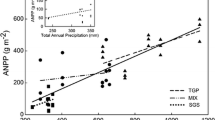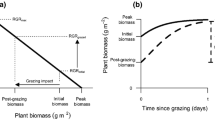Abstract
Patterns and controls of annual aboveground net primary productivity (ANPP) are fundamental metrics of ecosystem functioning. It is generally assumed, but rarely tested, that determinants of ANPP in one region within a biome will operate similarly throughout that biome, as long as physiognomy and climate are broadly consistent. We tested this assumption by quantifying ANPP responses to fire, grazing history, and nitrogen (N) addition in North American (NA) and South African (SA) savanna grasslands. We found that total ANPP responded in generally consistent ways to fire, grazing history, and N addition on both continents. Annual fire in both NA and SA consistently stimulated total ANPP (28–100%) relative to unburned treatments at sites with deep soils, and had no effect on ANPP in sites with shallow soils. Fire did not affect total ANPP in sites with a recent history of grazing, regardless of whether a single or a diverse suite of large herbivores was present. N addition interacted strongly and consistently with fire regime in both NA and SA. In annually burned sites that were not grazed, total ANPP was stimulated by N addition (29–39%), but there was no effect of N fertilization in the absence of fire. In contrast, responses in forb ANPP to fire and grazing were somewhat divergent across this biome. Annual fire in NA reduced forb ANPP, whereas grazing increased forb ANPP, but neither response was evident in SA. Thus, despite a consistent response in total ANPP, divergent responses in forb ANPP suggest that other aspects of community structure and ecosystem functioning differ in important ways between these mesic savanna grasslands.







Similar content being viewed by others
References
Allen-Diaz B. 1996. Rangeland in a changing climate: impacts, adaptations and mitigation. In: Watson RT, Zinyowera MC, Moss RH, Dokken DJ, Eds. Climate change 1995. Impacts, adaptations and mitigation of climate change: scientific-technical analyses. Cambridge: Cambridge University Press. p 131.
Archer S. 1995. The role of herbivores in mediating grass-woody plant interactions. Trop Grasslands 29:218–35.
Archibald S, Bond WJ. 2004. Grazer movements: spatial and temporal responses to burning in a tall-grass African savanna. Int J Wildland Fire 13:377–85.
Axelrod DI. 1985. Rise of the grassland biome, central North America. Bot Rev 51:163–201.
Baer SG, Blair JM, Knapp AK, Collins SL. 2003. Soil resources regulate productivity and diversity in newly established tallgrass prairie. Ecology 84:724–35.
Biggs R, Biggs HC, Dunne T, Govender N, Potgieter ALF. 2003. What is the design of the Experimental Burning Plot (EBP) trial in the Kruger National Park? Koedoe 46:1–15.
Blair JM. 1997. Fire, N availability and plant response in grasslands: a test of the transient maxima hypothesis. Ecology 78:2359–68.
Blair JM, Seastedt TR, Rice CW, Ramundo RA. 1998. Terrestrial nutrient cycling in tallgrass prairie. In: Knapp AK, Briggs JM, Hartnett DC, Collins SC, Eds. Grassland dynamics: long-term ecological research in tallgrass prairie. New York: Oxford University Press. p 222–43.
Bond WJ, Midgley GF, Woodward FI. 2003. What controls South African vegetation—climate or fire? S Afr J Bot 69:79–91.
Briggs JM, Knapp AK. 1995. Interannual variability in primary production in tallgrass prairie: climate, soil moisture, topographic position and fire as determinants of aboveground biomass. Am J Bot 82:1024–30.
Briggs JM, Knapp AK. 2001. Determinants of C-3 forb growth and production in a C-4 dominated grassland. Plant Ecol 152:93–100.
Burns CE, Zin AD, Govender N, Buis GM, Burkepile DE, Smith MD. The distribution of large herbivores in a fire-managed savanna grassland: assessing the role of bottom up processes (submitted).
Chapin FS III. 1989. Lack of compensatory growth under phosphorus deficiency in grazing-adapted grasses from the Serengeti plains. Oecologia 79(4):551–7.
Coetsee C, February EC, Bond WJ. 2008. Nitrogen availability is not affected by frequent fire in a South African savanna. J Trop Biol 24:647–54.
Collins SL, Steinauer EM. 1998. Disturbance, diversity, and species interactions in tallgrass prairie. In: Knapp AK, Briggs JM, Hartnett DC, Collins SC, Eds. Grassland dynamics: long-term ecological research in tallgrass prairie. New York: Oxford University Press. p 140–56.
Collins SL, Knapp AK, Briggs JM, Blair JM, Steinauer EM. 1998. Modulation of diversity by grazing and mowing in native tallgrass prairie. Science 280:745–7.
Coppock DL, Detling JK. 1986. Alteration of bison and black-tailed prairie dog grazing interaction by prescribed burning. J Wildl Manag 50:452–5.
Craine JM, Morrow C, Stock WD. 2008. Nutrient concentration rations and co-limitation in South African grasslands. New Phytol 178(3):829–36.
Diaz S, Lavorel S, McIntyre S, Falczuk V, Casanoves F, Milchunas DG, Skarpe C, Rusch G, Sternberg M, Noy-Meir I, Landsberg J, Zhang W, Clark H, Campbell BD. 2007. Plant responses to grazing—a global synthesis. Global Change Biol 13:313–41.
du Toit JT. 2003. Large herbivores and savanna heterogeneity. In: du Toit JT, Rogers KH, Biggs HC, Eds. The Kruger experience: ecology and management of savanna heterogeneity. Washington, DC: Island Press. p 292–309.
du Toit JT, Rogers KH, Biggs HC, Eds. 2003. The Kruger experience, ecology and management of savanna heterogeneity. Washington, DC: Island Press.
Dynesius M, Jansson R, Hohansson ME, Nilsson C. 2004. Intercontinental similarities in riparian-plant diversity and sensitivity to river regulation. Ecol Appl 14:173–91.
Fahnestock JT, Knapp AK. 1993. Water relations and growth of tallgrass prairie forbs in response to selective grass herbivory by bison. Int J Plant Sci 154(3):432–40.
Frank DA, Evans RD. 1997. Effects of native grazers on grassland N cycling in Yellowstone National Park. Ecology 78:2238–48.
Frank DA, McNaughton SJ, Tracy B. 1998. The ecology of the earth’s grazing ecosystems. Bioscience 48:513–21.
Fuhlendorf SD, Engle DM. 2001. Restoring heterogeneity on rangelands: ecosystem management based on evolutionary grazing patterns. Bioscience 51:625–32.
Fynn RWS, Haynes RJ, O’Connor TG. 2003. Burning causes long-term changes in soil organic matter content of a South African grassland. Soil Biol Biochem 35:677–87.
Fynn RWS, Morris CD, Edwards TJ. 2004. Effect of burning and mowing on grass and forb diversity in a long-term grassland experiment. Appl Veg Sci 7:1–10.
Fynn RWS, Morris CD, Kirkman KP. 2005a. Plant strategies and trait trade-offs influence trends in competitive ability along gradients of soil fertility and disturbance. Ecology 93:384–94.
Fynn RWS, Morris CD, Edwards TJ. 2005b. Long-term compositional responses of a South African mesic grassland to burning and mowing. Appl Veg Sci 8:5–12.
Georgiadis NJ. 1989. Ecological conditions that determine when grazing stimulates grass production. Oecologica 81(3):316–22.
Harris WN, Moretto AS, Distel RA, Boutton TW, Boo RM. 2007. Fire and grazing in grasslands of the Argentine caldenal: effects on plant and soil carbon and nitrogen. Acta Oecol 32:207–14.
Hartnett DC, Hickman HR, Walter LEF. 1996. Effects of bison grazing, fire and topography on floristic diversity in tallgrass prairie. J Range Manag 49:413–20.
Hartshorn AS, Coetsee C, Chadwick OA. 2009. Pyromineralization of soil phosphorus in a South African savanna. Chem Geol. doi:10.1016/j.chemgeo.2009.03.021.
Heisler JL, Briggs JM, Knapp AK. 2003. Long-term patterns of shrub expansion in a C4-dominated grassland: fire frequency and the dynamics of shrub cover and abundance. Am J Bot 90:423–8.
Hobbs NT, Schimel DS, Owensby CE, Ojima DS. 1991. Fire and grazing in the tallgrass prairie: contingent effects on nitrogen budgets. Ecology 72:1374–82.
Holland EA, Detling JK. 1990. Plant response to herbivory and belowground nitrogen cycling. Ecology 71:1040–9.
Huxman TE, Smith MD, Fay PA, Knapp AK, Shaw MR, Loik ME, Smith SD, Tissue DT, Zak JC, Weltzin JF, Pockman WT, Sala OE, Haddad BM, Harte J, Koch GW, Schwinning S, Small EE, Williams DG. 2004. Convergence across biomes to a common rain-use efficiency. Nature 429:651–4.
Johnson LC, Matchett JR. 2001. Fire and grazing regulate belowground processes in tallgrass prairie. Ecology 82:3377–89.
Knapp AK, Seastedt TR. 1986. Detritus accumulation limits productivity in tallgrass prairie. Bioscience 36:662–8.
Knapp AK, Briggs JM, Blair JM, Turner CL. 1998a. Patterns and controls of aboveground net primary production in tallgrass prairie. In: Knapp AK, Briggs JM, Hartnett DC, Collins SC, Eds. Grassland dynamics: long-term ecological research in tallgrass prairie. New York: Oxford University Press. p 193–12.
Knapp AK, Briggs JM, Hartnett DC, Collins SL, Eds. 1998b. Grassland dynamics: long-term ecological research in tallgrass prairie. New York, NY: Oxford University Press.
Knapp AK, Blair JM, Briggs JM, Collins SL, Hartnett DC, Johnson LC, Towne EG. 1999. The keystone role of bison in North American tallgrass prairie. Bioscience 49:39–50.
Knapp AK, Fay PA, Blair JM, Collins SL, Smith MD, Carlisle JD, Harper CW, Danner BT, Lett MS, McCarron JK. 2002. Rainfall variability, carbon cycling and plant species diversity in a mesic grassland. Science 298:2202–5.
Knapp AK, Smith MD, Collins SL, Zambatis N, Peel M, Emery S, Wojdak J, Horner-Devine MC, Biggs H, Kruger J, Andelman SJ. 2004. Searching for generality in ecology: testing North American grassland rules in South African savannas. Front Ecol Environ 9:483–91.
Knapp AK, Burns CE, Fynn RWS, Kirkman KP, Morris CD, Smith MD. 2006. Convergence and contingency in production–precipitation relationships in North American and South African C4 grasslands. Oecologia 149:456–64.
Lawton JH. 1999. Are there general laws in ecology? Oikos 84:177–92.
Lusk C, Bellingham P. 2004. Austral challenges to northern hemisphere orthodoxy. New Phytol 162:248–50.
Martin PS. 1984. Prehistoric overkill: the global model. In: Martin PS, Klein RG, Eds. Quaternary extinctions: a prehistoric revolution. Tucson, AZ: University of Arizona Press. p 354–403.
McNaughton SJ. 1983. Serengeti grassland ecology: the role of composite environmental factors and contingency in community organization. Ecol Monogr 53:291–320.
McNaughton SJ. 1984. Grazing lawns: animals in herds, plant form, and coevolution. Am Nat 124(6):863–86.
McNaughton SJ. 1985. Ecology of a grazing ecosystem: the Serengeti. Ecol Monogr 55:259–94.
McNaughton SJ, Osterheld M, Frank DA, Williams KJ. 1989. Ecosystem-level patterns of primary productivity and herbivory in terrestrial habitat. Nature 341:142–4.
Melzer S. 2009. Pedological and ecological controls on biogenic silica cycling in grass dominated ecosystems. PhD Dissertation, Department of Soil and Crop Sciences, Colorado State University, Fort Collins.
Milchunas DG, Lauenroth WK. 1993. Quantitative effects of grazing on vegetation and soils over a global range of environments. Ecol Monogr 63:327–66.
Milchunas DG, Sala OE, Lauenroth WK. 1988. A generalized model of the effects of grazing by large herbivores on grassland community structure. Am Nat 132:87–106.
Morris C, Tainton N. 2002. Lessons from Africa. Rangelands 24:8–12.
Navarrete SA, Broitman BR, Menge BA. 2008. Interhemispheric comparison of recruitment to intertidal communities: pattern persistence and scales of variation. Ecology 89:1308–22.
Nippert JB, Knapp AK, Briggs JM. 2006. Intra-annual rainfall variability and grassland productivity: can the past predict the future? Plant Ecol 184:65–74.
Oesterheld M, Loreti J, Semmartin M, Paruelo JM. 1999. Grazing, fire and climate effects on primary productivity of grasslands and savannas. In: Walker LR, Ed. Ecosystems of disturbed ground in Ecosystems of the World 16. Amsterdam: Elsevier. p 287–306.
Ojima DS, Schimel DS, Parton WJ, Owensby CE. 1994. Long- and short-term effects of fire on nitrogen cycling in tallgrass prairie. Biogeochemistry 24:67–84.
Owen-Smith RN. 1988. Megaherbivores: the influence of very large body size on ecology. Cambridge: Cambridge University Press.
Ransom MD, Rice CW, Todd TC, Wehmueller WA. 1998. Soils and soil biota. In: Knapp AK, Briggs JM, Hartnett DC, Collins SC, Eds. Grassland dynamics: long-term ecological research in tallgrass prairie. New York: Oxford University Press. p 48–66.
Rutherford MC. 1980. Annual plant production-precipitation relations in arid and semi-arid regions. S Afr J Sci 76:53–6.
Sala OE, Parton WJ, Joyce LA, Lauenroth WK. 1988. Primary production of the central grassland region of the United States: spatial pattern and major controls. Ecology 69:40–5.
Schimel DS, Braswell BH, Holland EA, McKeown R, Ojima DS, Painter TH, Parton WJ, Townsend AR. 1994. Climatic, edaphic, and biotic controls over storage and turnover of carbon in soils. Global Biogeochem Cycles 8:279–93.
Scholes RJ. 1993. Nutrient cycling in semi-arid grasslands and savannas: its influence on pattern, productivity and stability. Proceedings of the XVII International Grasslands Congress 1993. Palmerston North, NZ: New Zealand Grassland Association. p 1331–4.
Scholes RJ, Archer SR. 1997. Tree-grass interactions in savannas. Annu Rev Ecol Syst 28:517–44.
Scholes RJ, Walker BH. 1993. An African savanna: synthesis of the Nylsvley study. Cambridge: Cambridge University Press. p 306.
Scholes MC, Scholes RJ, Otter LB, Woghiren AJ. 2003a. Biogeochemistry: the cycling of elements. In: du Toit JT, Rogers KH, Biggs HC, Eds. The Kruger experience: ecology and management of savanna heterogeneity. Washington, DC: Island Press. p 130–48.
Scholes RJ, Bond WJ, Eckhardt HC. 2003b. Vegetation dynamics in the Kruger ecosystem. In: du Toit JT, Rogers KH, Biggs HC, Eds. The Kruger experience: ecology and management of savanna heterogeneity. Washington, DC: Island Press. p 242–62.
Seastedt TR, Briggs JM, Gibson DJ. 1991. Controls of nitrogen limitation in tallgrass prairie. Oecologia 87:72–9.
Swemmer AM, Knapp AK. 2008. Defoliation synchronizes above-ground growth of co-occurring C4 grass species. Ecology 89:2860–7.
Swemmer AM, Knapp AK, Snyman HA. 2007. Intra-seasonal precipitation patterns and aboveground productivity in three perennial grasslands. J Ecol 95:780–8.
Turner CL, Knapp AK. 1996. Responses of a C4 grass and three C3 forbs to variation in nitrogen and light in tallgrass prairie. Ecology 77(6):1738–49.
Uys RG, Bond WJ, Everson TM. 2004. The effect of different fire regimes on plant diversity in southern African grasslands. Biol Conserv 118:489–99.
Venter FJ, Scholes RJ, Eckhardt HC. 2003. The abiotic template and its associated vegetation pattern. In: du Toit JT, Rogers KH, Biggs HC, Eds. The Kruger experience: ecology and management of savanna heterogeneity. Washington, DC: Island Press. p 83–129.
Vinton MA, Hartnett DC, Finck EJ, Briggs JM. 1993. Interactive effects of fire, bison (Bison bison) grazing and plant community composition in tallgrass prairie. Am Midl Nat 129:10–8.
Walker BH. 1985. Structure and function of savannas: an overview. In: Tothill JC, Mott JJ, Eds. Ecology and management of the World’s Savannas. Slough: CAB Press. p 81–91.
Yang Y, Fang J, Ma W, Wang W. 2008. Relationship between variability in aboveground net primary production and precipitation in global grasslands. Geophys Res Lett 35:L23710. doi:10.1029/2008GL035408.
Acknowledgements
We thank the staff of Kruger National Park for creating and maintaining the Experimental Burn Plots and Buffalo Enclosure, and for their efforts in supporting and encouraging our work. In particular, we thank Justice Sibuyi, Wisane Sibuyi, and Thembe Mabasa for field assistance. We would also like to thank UKZN for their support of our study at URF. Research at KPBS was supported by the KPBS staff and Konza Prairie LTER program. Special thanks to Jobie Carlisle, Patrick O’Neal, Jerry Naiken, and Freedom Linda for logistical support. Gene Kelly and Suellen Melzer provided soils information and data. This research was supported by the National Science Foundation (DEB 0516145 to MDS, and DEB 0516094 to AKK). GMB was supported by the National Science Foundation’s GK12 program at Colorado State University. Long-term ANPP data set pab01 was supported by the NSF Long-Term Ecological Research Program at Konza Prairie Biological Station. Three anonymous reviewers improved this manuscript substantially.
Author information
Authors and Affiliations
Corresponding author
Additional information
Conceived of or designed study: AKK, MDS, GMB, SLC, JMB, NG, RWSF, CEB.
Performed research: GMB, RWSF, DEB, AJC, KPK, JMB.
Analyzed data: GMB, PLC.
Wrote the paper: GMB, AKK, SLC, JMB, MDS, DEB, RWSF.
Rights and permissions
About this article
Cite this article
Buis, G.M., Blair, J.M., Burkepile, D.E. et al. Controls of Aboveground Net Primary Production in Mesic Savanna Grasslands: An Inter-Hemispheric Comparison. Ecosystems 12, 982–995 (2009). https://doi.org/10.1007/s10021-009-9273-1
Received:
Revised:
Accepted:
Published:
Issue Date:
DOI: https://doi.org/10.1007/s10021-009-9273-1




